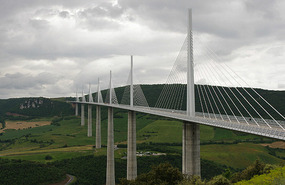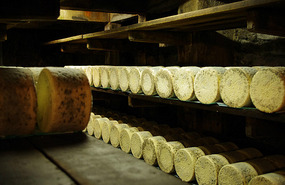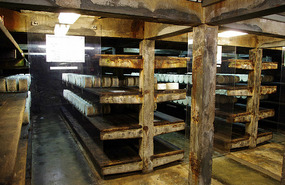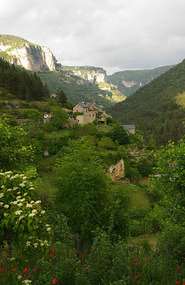We started the day off at the campsite's restaurant with a petit déjeuner (breaky). The petit déjeuner over here consists of a large hot beverage of your choice (café au lait for us), a croissant, about half a baguette and jam and sometimes orange juice. It was fairly good although not as good as the one we had in the boulangerie with Dad & Tan. We then set off from St. Cirq with a couple of hours of driving ahead of us and a few hundred kilometres before arriving in the Cevennes. We headed in towards Millau with the idea of stopping off en route for a view of the viaduct. As we went through a roundabout, we saw a sign pointing to a view point and an info centre at the viaduct. We thought this would be interesting to check out and continued on following the signs until we arrived at the parking. The visitor’s centre was actually quite large and the parking for the people coming off the autoroute was huge.
I guess all the tourists who drive over the viaduct like to stop to check it out – there were certainly a lot of parking spots. We headed up the hill to the viewpoint and were above the deck level of the viaduct so we could see the cars zipping across. The view really was quite impressive and you could see the seven columns supporting the bridge quite well. We then returned to the visitor’s centre where we watched a great video on the construction of the viaduct and learned some interesting facts. I thought the most interesting part of the construction was how they moved the deck into place. They build temporary support pillars to support the deck when it was between the permanent piers. Then they pushed the deck from one end of the valley towards the middle and then did the same from the other side. Eventually the two decks met in the middle where they were joined. There was one of the hydraulic jack type translators they used to move the deck outside of the visitor’s centre and a diagram showing how it worked.
A few facts about the viaduct are below:
- Construction started on December 14, 2001 and ended 3 years later
- Total height: 343 m
- Total length: 2 460 m
- Steel deck: 36 000 metric tons
- Highest pier: 245 m
After visiting the viaduct we continued on our way, glad that we had stopped off. We drove south of Millau towards Roquefort to visit the caves. We arrived around 3 pm which was getting a bit late since we still had a bit of a drive afterwards. Nevertheless, we were quite keen to tour the caves and after reading through a few options in the guidebook, walked uphill to one which makes the cheese in the traditional way and does everything by hand.
Unfortunately they were done for the day and while the info panels and video were interesting, what we had wanted to see was them making the cheese and the caves. We returned to town and walked up the street further hoping to get a guided tour of a cave. We arrived at the Papillon cheese makers first and they said that they had a tour starting in about 15 minutes. We thought that was great and settled in to wait. This tour was more what we had been hoping for as they actually took us into the caves where they used to age the Roquefort. The caves we visited were four levels high and the caves they currently use are eight levels high. They don’t use those particular caves anymore except for a few rounds of Roquefort on one level because of the health regulations relating to the wooden shelving. We started the tour with a short video on how Roquefort used to be made followed by how it is made today. Then we entered the top level of the cave where we could see that the rounds of cheese were showing lots of blue as they had been in the cave for 19 out of their 20 day stay. After the 20 days which allows the blue to ripen sufficiently, the loafs (rounds) are covered in tinfoil to slow down the development of the blue and the cheese is placed in a special climate controlled room where it ripens for a minimum of 90 days.
The oldest level of the cave we visited dates from 1830 and the oak shelving was 160 years old! Our last stop was to see the fungus, Penicillium Roqueforti, which is what they sprinkle the curds with to develop the blue in the caves. To obtain the fungus, in September, they bake 500 loaves of rye bread with 80% rye and 20 % wheat flour. Then the loaves are baked very quickly in a very hot wood fire so that the outside of the bread burns and the inside of the bread stays uncooked. Then the loaves are left for forty days to go mouldy; next they take off the crust and the inside of the bread is left to dry at 35 C. Finally, the bread is ground and sifted to obtain only the blue green powder. 100 grams of P.R. is enough to make one ton of cheese; in one gram of P.R. there are 25 billion spores. The tour finished off with a tasting of their cheese products which Mom and I avoided since they are all made with sheep’s milk and smelled rather strong. We were very glad that we had gone on this tour since it was much more interesting than the previous one and it gave us a much better idea of how the Roquefort was made.
We set off around 6 pm and drove back through Millau before heading off towards Meyrueis. We called ahead to the campsite since we weren’t sure if arriving between 8-8:30 would be ok as it was getting late, but they said that wasn’t a problem.
Many campsites have gates which need a code to get in or a card so you usually have to get to camp by 7 pm or so for the reception to be open. On the way we enjoyed the views of the small towns sprinkled here and there. We pulled over to take a picture of a town perched on a hill and there happened to be a cherry stand. They were the first of the season and had just been picked that afternoon. We picked up a kilo, got back to the car and then decided we should have one more since they were so good. We continued on our way through the Jonte gorge, munching on cherries and stopping at all the pullouts and viewpoints. It was a beautiful drive as we were high above the gorge twisting our way along. We enjoyed looking at all the rock formations and spotted lots of vultures circling overhead. We arrived at camp and the owner came down to check us in; she thought we looked familiar and we said that we had camped there in 2008. We set up and had a late dinner, glad to be in camp after a long day.
Millau Viaduct and the Roquefort Caves
Monday, June 10, 2013
 Millau, Midi-Pyrénées, France
Millau, Midi-Pyrénées, France
Other Entries
-
137Coastal Walk & Saint Malo
May 1427 days prior Saint-Malo, Francephoto_camera21videocam 0comment 0
Saint-Malo, Francephoto_camera21videocam 0comment 0 -
138Fort-la-Latte & Cap Frehel
May 1526 days prior Fort-la-Latte, Francephoto_camera40videocam 0comment 0
Fort-la-Latte, Francephoto_camera40videocam 0comment 0 -
139Paimpol & the Sillon de Talbert
May 1625 days prior Paimpol, Francephoto_camera24videocam 0comment 0
Paimpol, Francephoto_camera24videocam 0comment 0 -
140Île-de-Bréhat
May 1724 days prior Île-de-Bréhat, Francephoto_camera74videocam 1comment 0
Île-de-Bréhat, Francephoto_camera74videocam 1comment 0 -
141Bird Spotting and the Pink Granite Coast
May 1823 days prior Perros-Guirec, Francephoto_camera56videocam 1comment 0
Perros-Guirec, Francephoto_camera56videocam 1comment 0 -
142Crepes in Roscoff and the Keremma dunes
May 2021 days prior Roscoff, Francephoto_camera46videocam 0comment 0
Roscoff, Francephoto_camera46videocam 0comment 0 -
143Beautiful views near Camaret
May 2219 days prior Camaret-sur-Mer, Francephoto_camera42videocam 0comment 0
Camaret-sur-Mer, Francephoto_camera42videocam 0comment 0 -
144Crepes in Locronan
May 2318 days prior Locronan, Francephoto_camera20videocam 0comment 0
Locronan, Francephoto_camera20videocam 0comment 0 -
145Quimper
May 2417 days prior Quimper, Francephoto_camera22videocam 0comment 0
Quimper, Francephoto_camera22videocam 0comment 0 -
146Artist Village of Pont Aven
May 2516 days prior Pont-Aven, Francephoto_camera8videocam 0comment 0
Pont-Aven, Francephoto_camera8videocam 0comment 0 -
147A relaxing day in Quiberon
May 2615 days prior Quiberon, Francephoto_camera15videocam 0comment 0
Quiberon, Francephoto_camera15videocam 0comment 0 -
148Megaliths and Thundershowers
May 2813 days prior Vannes, Francephoto_camera35videocam 0comment 0
Vannes, Francephoto_camera35videocam 0comment 0 -
149Marais Poitevin
Jun 019 days prior Saint-Hilaire-la-Palud, Francephoto_camera45videocam 1comment 0
Saint-Hilaire-la-Palud, Francephoto_camera45videocam 1comment 0 -
150Ile de Ré
Jun 037 days prior Saint-Martin-de-Ré, Francephoto_camera45videocam 0comment 0
Saint-Martin-de-Ré, Francephoto_camera45videocam 0comment 0 -
151Exploring around Royan
Jun 064 days prior Royan, Francephoto_camera97videocam 0comment 0
Royan, Francephoto_camera97videocam 0comment 0 -
152Sarlat Market, a third visit
Jun 082 days prior Sarlat-la-Canéda, Francephoto_camera50videocam 0comment 0
Sarlat-la-Canéda, Francephoto_camera50videocam 0comment 0 -
153Saint-Cirq-Lapopie and the Cuzals farm museum
Jun 091 day prior Saint-Cirq-Lapopie, Francephoto_camera93videocam 3comment 0
Saint-Cirq-Lapopie, Francephoto_camera93videocam 3comment 0 -
154Millau Viaduct and the Roquefort Caves
Jun 10 Millau, Francephoto_camera37videocam 0comment 0
Millau, Francephoto_camera37videocam 0comment 0 -
155Scenic Drives, Views and Caves near Meyrueis
Jun 144 days later Meyrueis, Francephoto_camera164videocam 3comment 0
Meyrueis, Francephoto_camera164videocam 3comment 0 -
156Commuting to the Camargue
Jun 166 days later Saliers par Arles, Francephoto_camera85videocam 0comment 2
Saliers par Arles, Francephoto_camera85videocam 0comment 2 -
157Exploring the Chateau in Les Baux
Jun 177 days later Les Baux de Provence, Francephoto_camera55videocam 0comment 1
Les Baux de Provence, Francephoto_camera55videocam 0comment 1 -
158Perched Village of Gordes
Jun 2010 days later Gordes, Francephoto_camera45videocam 0comment 0
Gordes, Francephoto_camera45videocam 0comment 0 -
159Great Market, Incredible Ice Cream & Amazing Views
Jun 2111 days later Lourmarin, Francephoto_camera42videocam 0comment 0
Lourmarin, Francephoto_camera42videocam 0comment 0 -
160Ochre Quarry in Roussillon
Jun 2212 days later Roussillon, Francephoto_camera77videocam 0comment 0
Roussillon, Francephoto_camera77videocam 0comment 0 -
161Sunday Market and Waterwheels
Jun 2313 days later L'Isle-sur-la-Sorgue, Francephoto_camera36videocam 0comment 0
L'Isle-sur-la-Sorgue, Francephoto_camera36videocam 0comment 0 -
162Fontaine de Vaucluse
Jun 2414 days later Fontaine de Vaucluse, Francephoto_camera52videocam 1comment 0
Fontaine de Vaucluse, Francephoto_camera52videocam 1comment 0 -
163Village des Bories, Menerbes and Lacoste
Jun 2515 days later Menerbes, Francephoto_camera51videocam 0comment 0
Menerbes, Francephoto_camera51videocam 0comment 0 -
164Sault, Gorge de la Nesque & Mont Ventoux
Jun 2616 days later Sault, Francephoto_camera42videocam 0comment 0
Sault, Francephoto_camera42videocam 0comment 0 -
165Seguret
Jun 2717 days later Seguret, Francephoto_camera24videocam 0comment 0
Seguret, Francephoto_camera24videocam 0comment 0 -
166Venasque & a Return to Isle sur Sorgue
Jun 2818 days later L'Isle-sur-la-Sorgue, Francephoto_camera37videocam 0comment 0
L'Isle-sur-la-Sorgue, Francephoto_camera37videocam 0comment 0 -
167Pernes-les-Fontaines
Jun 2919 days later Pernes-les-Fontaines, Francephoto_camera29videocam 1comment 3
Pernes-les-Fontaines, Francephoto_camera29videocam 1comment 3 -
168The Tour de France speeds by
Jul 0424 days later Maussane-les-Alpilles, Francephoto_camera33videocam 1comment 0
Maussane-les-Alpilles, Francephoto_camera33videocam 1comment 0 -
169Hiking in the Alpilles
Jul 0525 days later Maussane-les-Alpilles, Francephoto_camera17videocam 0comment 0
Maussane-les-Alpilles, Francephoto_camera17videocam 0comment 0 -
170Colorado Provencal
Jul 0727 days later Rustrel, Francephoto_camera28videocam 0comment 4
Rustrel, Francephoto_camera28videocam 0comment 4 -
171Abbaye de Valsaintes & Simiane-la-Rotonde
Jul 0828 days later Simiane-la-Rotonde, Francephoto_camera57videocam 0comment 0
Simiane-la-Rotonde, Francephoto_camera57videocam 0comment 0 -
172Exploring the Verdon Gorge
Jul 1232 days later Moustiers Sainte-Marie, Francephoto_camera97videocam 1comment 0
Moustiers Sainte-Marie, Francephoto_camera97videocam 1comment 0

 Millau, Midi-Pyrénées, France
Millau, Midi-Pyrénées, France





































2025-05-22